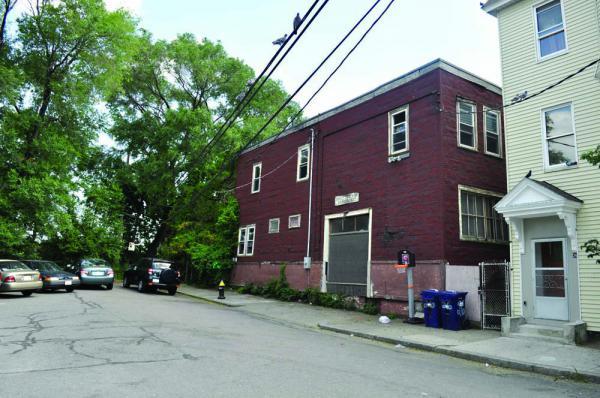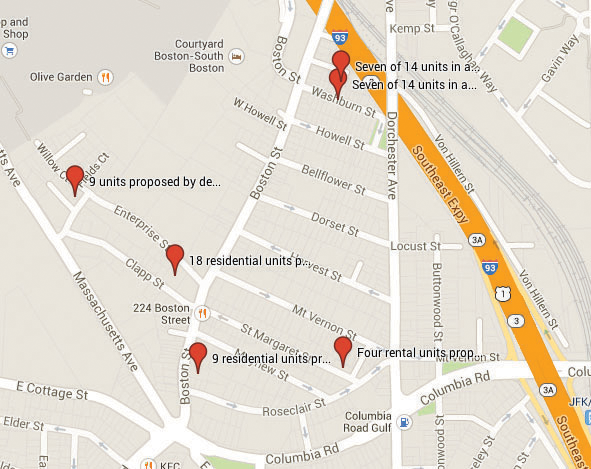June 26, 2014

This building at 24 Rawson St. is to be razed along with abutting 27 Washburn St. in a joint project that will potentially create two seven-unit buildings with below-ground parking by developers James Baker and Douglas George. Photo by Bill Forry
Dorchester’s Polish Triangle is ground zero for the housing development spilling into Boston’s largest neighborhood. Case in point: At last week’s meeting of the John W. McCormack Civic Association, which oversees Dot’s northernmost village commonly called the Polish Triangle, members entertained four development proposals accounting for a total of 45 housing units, the bulk of which is within a radius of a block and a half.
There’s no denying the demand for housing. This winter, the Metropolitan Area Planning Council released a report saying that greater Boston needs an additional 305,000 housing units over the next 25 years, with over 50 percent of new housing production sited in urban communities such as Dorchester.
“It’s the only place to build,” said Douglas George, a developer who lives in the Triangle neighborhood and has bought and built a number of properties, including nine units at 246 Boston St.
George went to last Wednesday’s meeting to speak to the community about his joint proposal with developer James Baker to demolish a ramshackle property and build 14 units between Washburn and Rawson streets on a parcel adjacent to the Southeast Expressway. “This is middle-market housing that we’re talking about and the only place we can build it is in the neighborhoods,” George said in an interview with the Reporter.
Under their plan, Baker and George will divide up the proposed 14 condo units, with Baker taking the seven that front Washburn and George the seven that front along Rawson, a dead-end street. This is a scaled-down version of their initial proposal for 15 units, a change prompted by concerns in the community, they said. At the meeting, only the Washburn property was up for a vote, which was tabled until the next meeting in September. Community members want to hear more specifics on the units’ rental vs. owner-occupancy breakdown, parking, and other details.
From the meeting, it was clear that many members remain concerned about parking and density, a problem in the area made worse by an influx of new residents. The two lots would share 26 parking spaces in below-ground parking, keeping the street clear, Baker said. He and George vowed to continue talks with the community to come up with a mutually beneficial design.
“We’ve met with the community three times and will continue to work with the community to come with a satisfactory solution for all parties,” Baker told the Reporter.
“I just don’t feel like they’re listening to the abutters,” said Michelle Mailloux, a neighbor of the Washburn Street development, said in an interview. “Our street is bad as it is, I can’t park at all,” Mailloux said. “It’d be fine if people actually used the parking. But a lot of people don’t use the parking that’s provided.”
The potential for additional renters in the area would be a burden, but Mailloux acknowledged the tradeoff for developing the Washburn lot, which she said is trash-laden and rat-infested. “Right now, it’s an abandoned lot, and anything will be better,” she said.
Developers are vying to build on other abandoned or dilapidated lots in the neighborhood, including a proposal for 18 units on the 14-acre site of a current unused commercial garage off Boston Street fronting Clapp and Enterprise streets.
 Pending building proposals in Polish Triangle— June 2014
Pending building proposals in Polish Triangle— June 2014
The developer, James Paskell, received a non-binding majority vote from the community in an effort to gauge support for the project before purchasing the land from the South Boston-based developer William Strigler. The city’s assessing database values the 8 Enterprise St. parcel at $665,000; it is zoned for commercial use. The plan would put in two sets of nine owner-occupied condos, as well as updated sidewalks on Clapp and Enterprise streets.
“This is a tremendous beautification of that street and location as well as a pedestrian walkway to the South Bay Mall,” Paskell told the association. Like George and Baker, he, too, came down from his initial proposal for 21 units in what he called an aggressive plan to respond to neighbors’ concerns about density and parking. Still, some community members weren’t sold on the plan.
“Eighteen units for that site seems incredibly large to me,” one person said in response to Paskell’s presentation at the meeting. Others expressed concern about noise from neighboring businesses, including an auto body shop, a roofing company, and a sand and gravel pit.
Paskell said the parcel’s sales price was forcing him to put more units in the location to which Millie Rooney, a McCormack executive board member, responded that she wasn’t sure if she believed the assertion. Rooney said she’s still not 100 percent on board with the 18-unit proposal, but she sees the benefit.
“If Paskell does get the okay to do the units, there will be more life down there,” Rooney said. “It won’t be as desolate at night.”
Across the street, developer Owen Kiernan is pushing to raze and build nine units on the site of what some believe is the city’s oldest three-family house. The property at 68 Willow Court is boarded up with smashed windows on a lot in need of a weed-whacker. Though many argue the dilapidated building is an eyesore, neighbors at the meeting called the proposed Kiernan development too dense for the area. They again voiced density concerns over the proposed 12 parking spaces.
Nevertheless, the plan was approved, with the condition that if the Landmark Commission grants the building historical status, Kiernan will have to come back before the civic association to re-work the building’s design.
Also discussed at the meeting was a proposal to demolish a home at 50 St. Margaret St. and replace it with a building with four units of housing, down from six in the original plan. The proposal requires zoning approval and will be back on the table in September.
If the McCormack meeting is any proof, it’s clear the Polish Triangle is the next frontier in Dorchester for the growing pains that come with a booming demand for housing and available space for development.
“Am I against the development? No,” Rooney said. “But to a point, it needs to stop. I don’t want this to be as congested as South Boston.”
Villages:
Topics:


